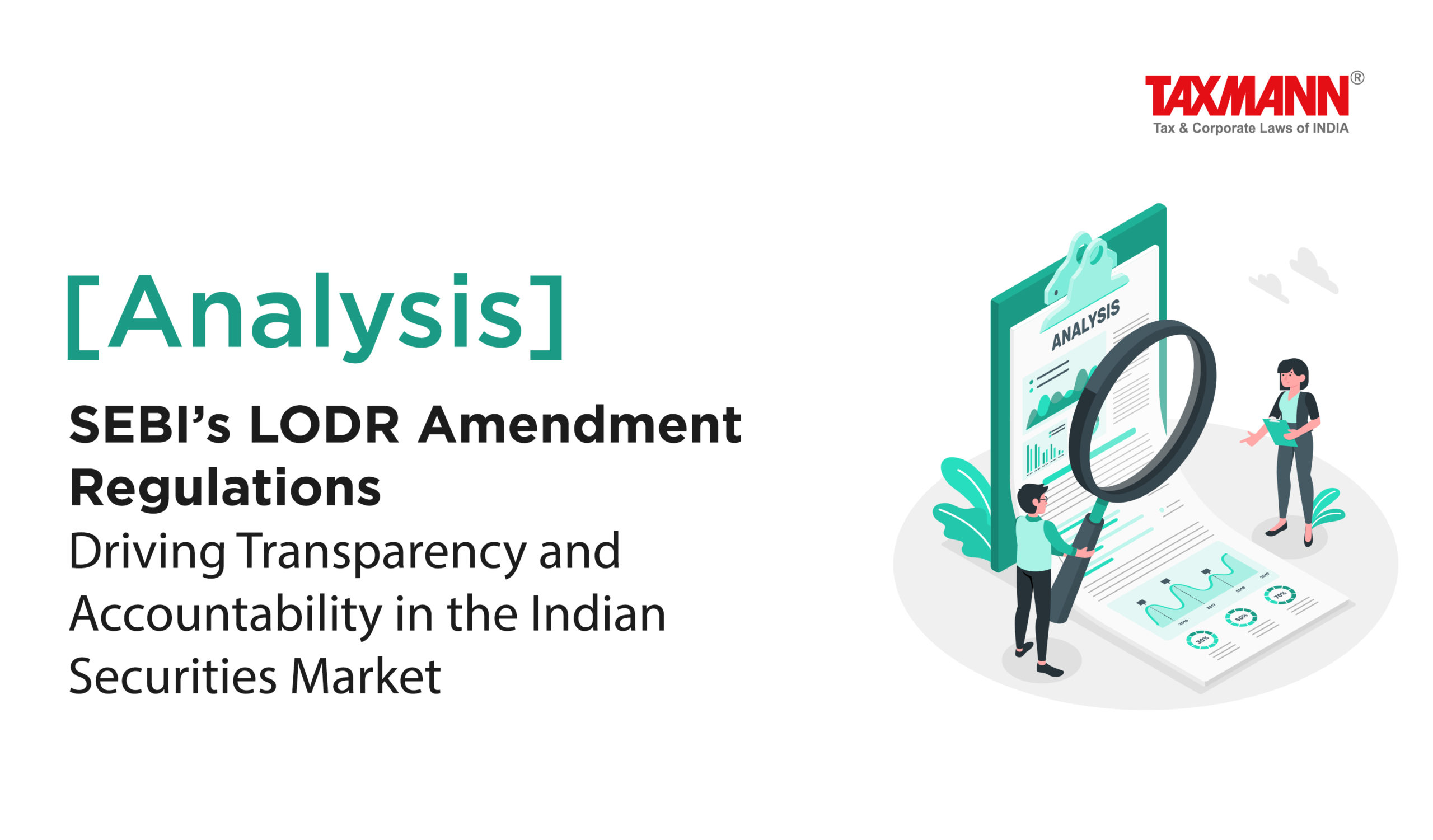[Analysis] SEBI’s LODR Amendment Regulations | Driving Transparency and Accountability in the Indian Securities Market
- Blog|Advisory|Company Law|
- 3 Min Read
- By Taxmann
- |
- Last Updated on 25 April, 2024

Table of Contents
- Introductory note
- Strengthened LODR Regulations Drive Greater Accountability
- Rationale behind the amendment
- Impact of the amendment
- Repercussions of the amendment
- Conclusion
1. Introductory note
Earlier, the Securities and Exchange Board of India made significant amendments to regulations 30 and 30A of the SEBI (LODR) Regulations, 2015. Later, through the SEBI Circular No. SEBI/HO/CFD/CFD-PoD-1/P/CIR/2023/123 dated 13.07.2023, the SEBI has outlined a comprehensive set of details that companies must provide while disclosing events mentioned in Part A of Schedule III of the LODR regulations.
Additionally, SEBI has now provided explicit guidance on determining the occurrence of an event or information for disclosures under regulation 30 of the LODR, as well as defining the criteria for considering a transaction as material. These regulatory changes, implemented on July 15, 2023, aim to enhance transparency and accountability in the securities market.
2. Strengthened LODR Regulations Drive Greater Accountability
In the past, companies held the authority to determine whether specific information or event qualify as “material” and require public disclosure. However, recent developments in corporate governance and regulatory practices have brought about a significant change to this discretionary approach.
Now, listed companies are required to disclose to the public all information on business deals and arrangements that have a bearing on their prospects. The amended LODR Regulations mandate firms to reveal all contracts and arrangements, pertaining to strategic, technical, manufacturing, and marketing tie-ups in an effort to boost transparency.
The amendments will necessitate companies to disclose to shareholders all deals without exception. An important change arises when existing or ongoing events gain significance based on objective criteria, requiring companies to review their past records and determine if any disclosures are necessary.
3. Rationale behind the amendment
A significant rationale behind the current amendments stems from the observation that certain listed companies faced allegations of withholding “material” information, even if it could potentially affect their profitability in the future. Enhanced disclosures aim to provide investors and analysts with more clarity on the business plans of companies especially when it comes to limited tenure contracts and tie-ups.
4. Impact of the amendment
As per the latest revisions in LODR norms, any contract obtained by the listed company, which deviates from its ordinary course of business, now requires the disclosure of its key terms. This obligation applies regardless of the presence of commercial or confidential details within the contract.
Generally, the disclosures pertain to contracts that fall outside the scope of the listed company’s usual business operations. These disclosures have the potential to provide retail investors, regulators, and competitors with insights into the current activities of the listed company that extend beyond what is typically expected from a publicly traded company.
5. Repercussions of the amendment
The imminent changes are set to trigger a flood of company disclosures, leading to a significant surge in compliance costs. Although the objective of delivering comprehensive information is commendable, it is undeniable that certain elements of the required disclosure are puzzling.
One area of concern is the disclosure obligation concerning contract awards and acquisitions. Delving into the essential terms and conditions of these agreements can reveal a complex web of commercial intricacies and confidentiality concerns, often leaving businesses perplexed and uncertain.
6. Conclusion
The prescribed list of details to be disclosed will facilitate clearer and more comprehensive reporting of events by companies. SEBI’s guidance on determining the occurrence of an event or information will bring further clarity to the disclosure process, ensuring timely and accurate dissemination of relevant information to investors and the market.
Overall, these amendments reflect SEBI’s commitment to maintaining a fair and transparent market environment, fostering investor confidence, and enabling informed decision-making.
Disclaimer: The content/information published on the website is only for general information of the user and shall not be construed as legal advice. While the Taxmann has exercised reasonable efforts to ensure the veracity of information/content published, Taxmann shall be under no liability in any manner whatsoever for incorrect information, if any.

Taxmann Publications has a dedicated in-house Research & Editorial Team. This team consists of a team of Chartered Accountants, Company Secretaries, and Lawyers. This team works under the guidance and supervision of editor-in-chief Mr Rakesh Bhargava.
The Research and Editorial Team is responsible for developing reliable and accurate content for the readers. The team follows the six-sigma approach to achieve the benchmark of zero error in its publications and research platforms. The team ensures that the following publication guidelines are thoroughly followed while developing the content:
- The statutory material is obtained only from the authorized and reliable sources
- All the latest developments in the judicial and legislative fields are covered
- Prepare the analytical write-ups on current, controversial, and important issues to help the readers to understand the concept and its implications
- Every content published by Taxmann is complete, accurate and lucid
- All evidence-based statements are supported with proper reference to Section, Circular No., Notification No. or citations
- The golden rules of grammar, style and consistency are thoroughly followed
- Font and size that’s easy to read and remain consistent across all imprint and digital publications are applied






